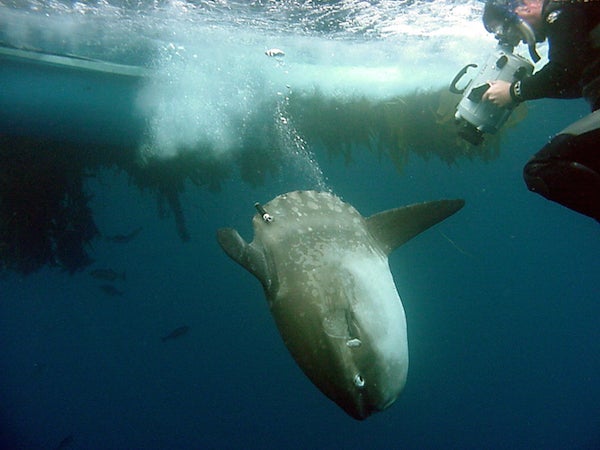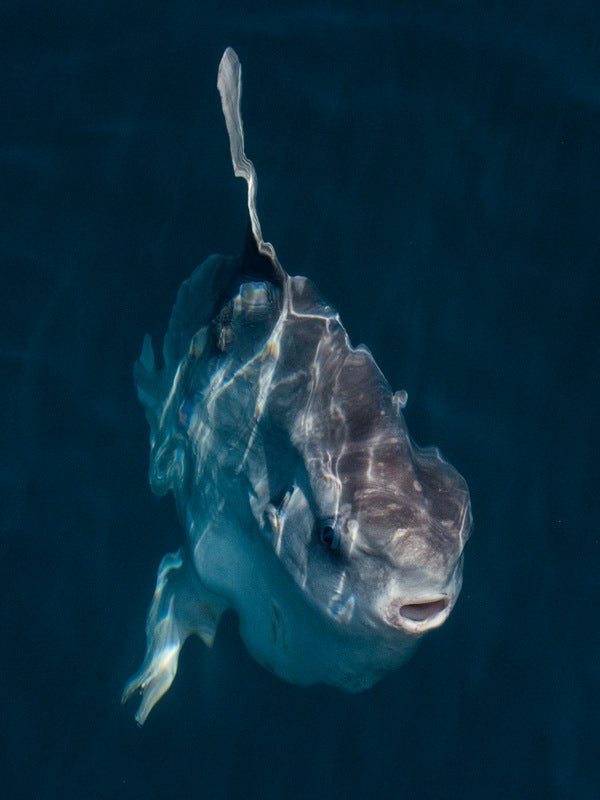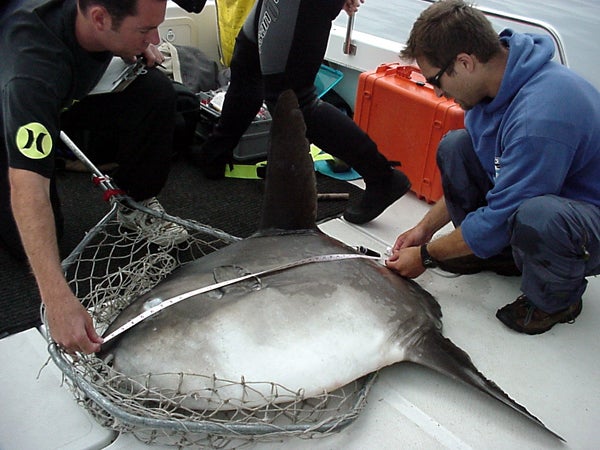This article was published in Scientific American’s former blog network and reflects the views of the author, not necessarily those of Scientific American
With a final breath of air, I descend beneath the surface among swaying kelp and flying sea lions. I’m in search of a creature that has eluded me for many years. As a freediver, I’ve met the humbling gaze of a tiger shark and tossed around seaweed with playful wild spotted dolphins. But I’ve never faced the puckered lips and buggy eyes of the whimsical Mola mola — a fish that can reach the weight of an adult rhinoceros.
Biologists have affectionately described Mola, or ocean sunfish, as a “a swimming head.” And while they seem to just float aimlessly at the surface, scientists are finding that these fish — which occupy a crucial evolutionary link in the fish family— are actually warming up after epic daily treks into deep water.
A testament to this bizarre nature, a viral video of the sunfish circulated in September of 2015. The expletive-shouting Boston fisherman is unsure if he’s witnessing a baby whale or sea turtle, two seemingly dissimilar animals. He’s not the only one.
On supporting science journalism
If you're enjoying this article, consider supporting our award-winning journalism by subscribing. By purchasing a subscription you are helping to ensure the future of impactful stories about the discoveries and ideas shaping our world today.
These fish live off the California coast and around the world in temperate and tropical areas. But many people have never heard of them, let alone seen one.
Mola mola are not endangered and not eaten in the United States. In fact, females can produce up to 300 million eggs, more than any other bony fish. But the hapless fish ends up tangled in fishing nets, as bycatch for more valuable target species. They make up the largest bycatch component (29 percent) in the California drift-gillnet swordfish fishery.
So why does it matter if Mola mola are caught in mesh nets?
Mola are pelagic, which means they live in the open ocean. Like humans, and many other fish, they have a bony internal skeleton. Sharks and rays, however, have a cartilaginous skeleton. According to some scientists, mola could provide a missing link to understand their open ocean neighbors animals, like sharks.
“Sunfish are one of the most advanced bony fish, but they have a lot in common with cartilaginous fish. What they have in common may be adaptive to pelagic life and to study it may lead to solve evolution of pelagic species,” says Itsumi Nakamura, a biologist at the University of Tokyo.

A researcher from the Shark Lab at Cal State Long Beach films a mola diving. Credit: Cal State Long Beach Shark Lab
Mola have lost the calcium carbonate that makes their skeleton hard, so it’s more like a shark skeleton, says Christopher Lowe, a professor of marine biology at Cal State Long Beach State. Also like sharks, they lack a swim bladder that helps most bony fish stay afloat. Being lighter means using less energy, which is important when you are searching for hard to find and low calorie dinner items, common for deep-sea eaters, he says.
Nakamura has studied the fish since 2009 and recently revealed mysteries of their strange behavior. Mola are often seen just lounging at the surface, he says. But new research published in the Journal of Animal Ecology from Nakamura and his team have found that mola actually make daily treks to the deep sea more than 2,600 feet beneath the surface — a place reserved for creatures like giant squid and diving sperm whales.

A mola lounges at the surface in Monterey Bay. Credit: Kate Cummings, Naturalist and Captain at Blue Ocean Whale Watch
Scientists have actually known mola dive deep for years. In fact, Lowe was one of the first scientists to track mola back in 2004. He speculated their diving behavior was related to regulating body temperature, but at the time scientists lacked the tools to test it, he says.
Nakamura and his team “did a really nice job of demonstrating that, using appropriate new technology,” says Lowe.
With the help of local fisherman in Funakoshi Bay, Nakamura’s team caught sunfish and outfitted them with thermometers, accelerometers, and video cameras.
Though they can reach 2,600 feet, most trips throughout the day averaged between 350-600 feet. Mola returned to warm surface waters in between dives. This sunbathing behavior regulates their body temperature, and allows them to stay at depth longer, concludes Nakamura. It may also explain their large size. Larger sunfish can hunt longer and lose heat at slower rates than smaller ones, he says.
So why journey to the dark and deep?
They are eating jellyfish-like creatures, called siphonophores, says Nakamura. And it turns out, after observing the camera from one mola, they might be dining on the most nutritious part of the animals- their sex organs.
“Of course I was surprised, because it is very novel that they eat only calorie rich parts of the jellyfish,” he says.
Relaxing at the surface has another benefit for the sunfish; it’s a trip to the spa. Mola line up at cleaning stations, while smaller fish peck parasites from their body. For a more thorough cleaning, mola swim to the surface and seagulls jab through their flesh, feasting on parasitic worms.
“They are a treasure trove for parasitologists,” says Lowe.
Nakamura isn’t alone in his quest to understand the mola mola. Scientists are still trying to fill in the gaps for this under-studied species.
This study demonstrates that mola are temperature sensitive, say Lowe. Global climate change and warming oceans will change their behavior and the distribution of their prey The question is, how? he asked.

Researchers from the Shark Lab team take measurements on Mola before releasing them. Credit: Cal State Long Beach Shark Lab
Tierney Thys has studied the mola for over 15 years and is researching everything from their vision and diving behavior, to pollutant levels. She recently published results from the first long-term tagging study of mola mola in the eastern Pacific in the Journal of Experimental Marine Biology and Ecology. They tagged 15 mola mola off the coast of southern California between 2003 and 2010. Of the 15 tagged individuals, four made dives greater than 1600 feet.
It seems California mola are also diving deep. And last year, a lucky southern California native met a mola mola in the open sea.
Ryan Brennan is the owner of a BMX bike show company, is a spearfisherman, and a freediver. He was headed 18 miles offshore on a foggy morning to go fishing with three friends. Still groggy from the 5:00 a.m. wake up call, he jumped into blue water. Like the Boston fisherman, Brennan had no idea what he was witnessing.
“One of my first thoughts was, wow this one of the ugliest fish I have ever seen,” says Brennan.
But Brennan spent time in the water, watching and observing the fish. And now, seeing the fish again is what he yearns to do the most, he says.
“I saw the eyeball looking at me,” he says. “The more I looked into the animal, I realized it’s really beautiful.”
Eventually the fish took off. And Brennan was surprised by how fast it moved.
“They are unbelievably athletic, even though they don’t look that way,” says Lowe.
The evidence is clear: the mola mola is more than just a lazy sun-bather. And while I have yet to meet one, I’ll continue weaving through kelp forests to find the “swimming head.”
Bethany Augliere is a journalist in the science communication program at the University of California, Santa Cruz. She holds a master's degree in marine biology from Florida Atlantic University. For more of her work, visit her website or follow her on Twitter @BethanyAugliere.